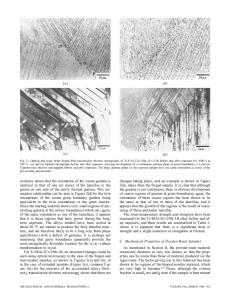Bonding-property relationships in intermetallic alloys
- PDF / 1,284,561 Bytes
- 11 Pages / 576 x 792 pts Page_size
- 102 Downloads / 387 Views
D. P. Clougherty Department of Physics, University of Vermont, Burlington, Vermont 05405-0125
J. M. MacLaren Department of Physics, Tulane University, New Orleans, Louisiana 70118 (Received 19 March 1992; accepted 29 October 1992)
A definition for structure of atomic scale systems is introduced which extends the typical crystallographic description to include elements of the total charge density. We argue that the mechanical properties of intermetallic alloys are related to this extended structure. These relationships have their origin in the nature of the charge redistribution accompanying strain. The direction of this charge redistribution is determined solely by the extended structure, while its magnitude can be correlated with a quantification of this extended structure. We demonstrate these facts by determining the extended structure and nature of the charge redistribution resulting from uniaxial strain for two alloys with the Ll 0 structure: CuAu and TiAl. While these alloys share the same crystallographic structure, their extended structures are different, with CuAu possessing the same extended structure as the allotropic fee metals while TiAl does not. These different extended structures give rise to different charge redistributions, which are argued to be related to the intrinsically ductile behavior of CuAu and the tendency for TiAl to fail transgranularly. I. INTRODUCTION The advent of new materials processing and fabrication techniques has made it possible to control atomic scale structure to an extent undreamt of only twenty years ago. If this improved control of the structure can be coupled with a more complete understanding of the relationships between structure and properties, the world will move one step closer to the ability to synthesize materials with a combination of properties tailored to the intended application. It is this ability which it is believed will accelerate the pace of technological advancement, which is increasingly materials limited. Virtually all technologies can profit from an improved control of mechanical properties, as mechanical properties are among those which limit the use of many materials whether their application is structural or nonstructural. With the importance of mechanical properties as an ultimate controller of materials performance, it is not surprising that much effort has been directed toward the control of these properties, resulting in a well-established methodology for improving mechanical response. This methodology, however, makes use of the relationships between microstructure and properties. For example, the control of a material's strength or creep resistance is accomplished by manipulating such elements of structure as dispersoid size or shape. Unfortunately, a methodology allowing for the selection of intrinsic mechanical properties through changes in atomic scale 438 http://journals.cambridge.org
J. Mater. Res., Vol. 8, No. 3, Mar 1993 Downloaded: 13 Mar 2015
structure has not been achieved. As an example, one of the mechanical properties which i
Data Loading...










